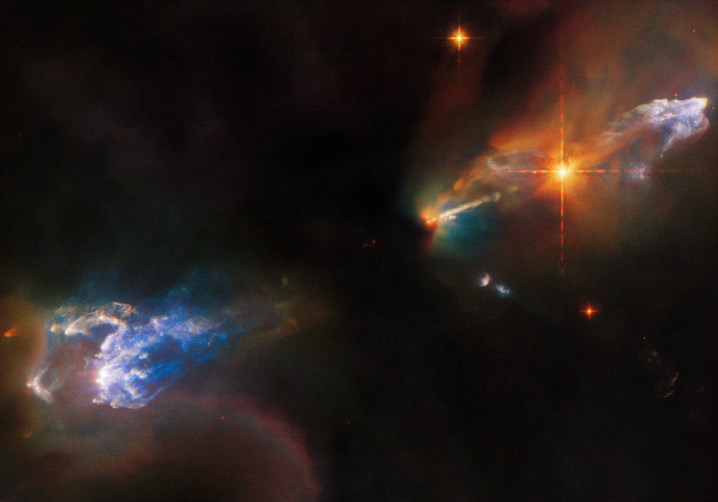This week’s image from the Hubble Space Telescope shows Herbig-Haro objects, a pair or objects captured by Hubble’s Wide Field Camera 3 instrument. The camera took the image using 11 different filters spread across the visible light, infrared, and ultraviolet wavelengths, allowing researchers to observe different features.
This pair of Herbig-Haro objects is located 1,250 light-years away in the constellation of Orion, and the objects are formed from the dramatic outbursts of newly born stars. They were the first Herbig-Haro objects to be recognized, leading to the names HH 1 and HH 2. Newly born stars only develop into Herbig-Haro objects under certain circumstances: The stars must give off jets of ionized gas which is extremely hot and charged. These jets hit nearby clouds of dust and gas, creating the glowing forms in the collision.

“While both Herbig-Haro objects are visible, the young star system responsible for their creation is lurking out of sight, swaddled in the thick clouds of dust at the center of this image,” Hubble scientists wrote. “However, an outflow of gas from one of these stars is streaming out from the central dark cloud and is visible as a bright jet. Astronomers once thought the bright star between that jet and the HH 1 cloud was the source of these jets, but it is an unrelated double star that formed nearby.”
Hubble has imaged similar Herbig-Haro objects before, such as when it captured objects HH 46 and HH 47 in the constellation of Vela or when it observed the object HH 34 in the Orion nebula, which is the site of vigorous star formation. One of Hubble’s most stunning and unusual images is of object HH 505, which is in a particularly colourful and attractive nebula that has been shaped and sculpted by the forces of the jets given off by young stars.
Editors' Recommendations
- Celebrate Hubble’s 34th birthday with this gorgeous nebula image
- Hubble spots a bright galaxy peering out from behind a dark nebula
- Hubble images the spooky Spider Galaxy
- Hubble spots a massive star forming amid clouds of dust and gas
- Hubble spies baby stars being born amid chaos of interacting galaxies



